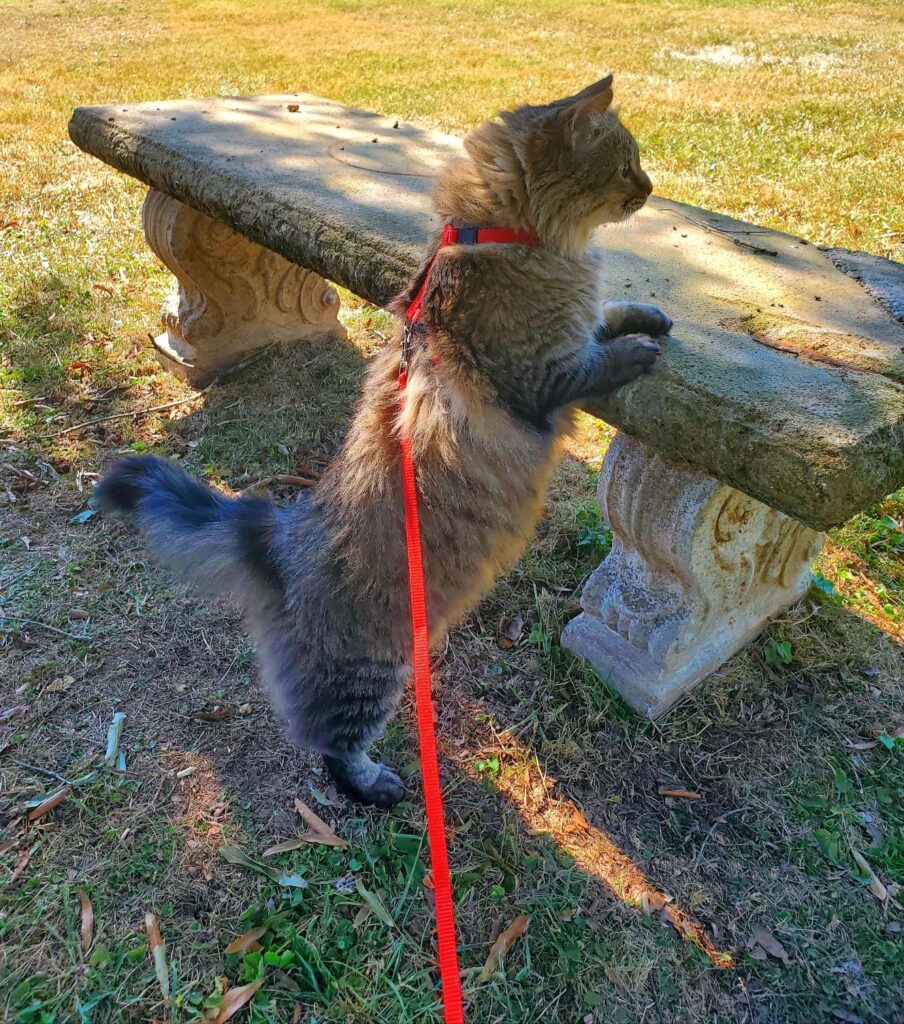There are many things to consider when thinking about adopting a new cat/kitten. Below we will go over a few points to help you decide if this is the right time in your life to add a new family member. Your goal should be the best fit for your current and future family situation and living areas and for this adoption to be your furbaby’s furever home.
This post contains affiliate links. We may earn compensation when you click on the links at no additional cost to you.
Cats can be very lively and have an abundance of emotions so your first research should be if you need a certain breed or special trait. An example would be an older cat is going to lay around more but would give you comfort if he/she is a lap cat with less running around in the middle of the night. Another example – do you have allergies? If so, we recommend researching cats that cause the least issues with allergies.
Kitten or young adult or older cat? Most people start this conversation saying I want a kitten. I can train him/her more easily and with kittens, I can start new with them. This is a great option as many kittens are born with no homes and need a furever adoption. Keep in mind an indoor-only cat averages a very long life span and could live 20+ years. An indoor/outdoor cat, sadly, has a much smaller lifespan of 3-5 years. Meeting a younger adult or older cat allows you to see more of their current personality and temperament. Cats of all ages are generally clean and should have no issue with litter box training even with moves as long as you work with them a few days. If they do have issues, it probably is a good idea to speak with your vet.
Your home environment is a must to consider for your adoption. Do you have other cats and/or dogs? Do you have children or plan to have children? It can be a real challenge to slowly introduce your new furbaby to your existing clan. The easiest way to introduce a new cat to the family is to separate everyone and allow them to meet one by one. While doing this you can control the environment and everyone in it. Mind you, it took a while for us to learn this method with nine cats. With each introduction, we tried several methods and found our best way was one on one introduction, but like anything, it is trial and error. What worked for us might not be the best solution for you.
Older cats and introductions? Kittens probably do adapt better to the first meet and greet but older cats may be more scared from past abuse or movement. We highly recommend allowing older cats the time required to adjust to this new environment. It can take them days, weeks, or months to be comfortable, but once they figure out you are their furever parents they usually relax.

See Brittney’s full comic about adopting cats here.
Quick note: Due to the lack of spaying and neutering for animals, losing interest, or moving and could not take their furbaby with them there are lots of loving cats waiting to be adopted into a good home. The animal shelter is always packed. Some of these cats are older and it is truly harder for them to get a home due to their age. People associate age with a lack of play or personality. When we rescued Sabrina from the shelter, she was 8 years old, she was talkative and loving. She is now 12 years old and a lot of times can run circles around the younger cats. Please consider the older ones in your options for adoption. According to the Humane Society “Of the 3 million cats and dogs euthanized in shelters each year, approximately 2.4 million (80%) are healthy and treatable and could have been adopted into new homes”. The ASPCA has recorded “Each year, approximately 1.5 million shelter animals are euthanized (670,000 dogs and 860,000 cats). The number of dogs and cats euthanized in U.S. shelters annually has declined from approximately 2.6 million in 2011. This decline can be partially explained by an increase in the percentage of animals adopted and an increase in the number of stray animals successfully returned to their owners.” On a plus note, yes the numbers are declining but they are still too high. Please spay or neuter.

Help Missy get home.
How do you decide? Almost every shelter offers a room where you can take a cat or kitten to play and see how yours and the cat’s personality interact. This is an important step because not all cats are the lovable, cuddling type. It’s important to note that whatever you imagine your ideal cat is to not be so strict to that ideology. A cat is going to do whatever a cat wants to do. Therefore, before adopting, know your cat will get into everything, sleep or lay wherever he/she pleases and there is very little you can do to change that.
Our thoughts on a breeder: We are not telling you to avoid breeders. Dad had a certain breed that he just loved. When he was growing up his grandparents breed and showed dogs at dog shows. Dad fell in love with the Pembroke Welsh Corgi breed. (Reminder we do have 9 cats but also 1 Corgi) So when it came time to adopt our own dog that is how we choose. We do have several different cat breeds as our favorites as well but all of our cats are rescued from the streets or the shelter. One of our adopted cats is a Siberian Cat named Aria. She came from the shelter. Taco was found at Taco Bell and he is a Maine Coon. If you have decided on a certain breed or special trait that will work best with your family and situation, we do feel with research, luck and maybe a short drive you may still be able to rescue from someone local or an animal shelter.
How will your cat live with you? Some people believe it is best to let their cat become an indoor/outdoor cat. Here at Kittystead, due to our circumstance of living in town, we do not allow our cats outdoors unless on a leash. We do understand this is a personal decision and needs to be considered before you bring your new furever furbaby home. 3 of our cats love the outdoors which is why we walk those 3 cats on a cat leash. Our other 6 cats have no interest in the outside other than looking out the window.

If you do decide to let your cat come and go as it pleases, then please make sure that the cat is protected from fleas and ticks and spayed/neutered. Outside or stray cats pose a real problem in many parts of the country. They can be preyed on by wildlife, cause or be involved in car accidents, damage the local flora, and frighten children. Spaying/neutering packs a powerful punch in reducing the number of animals on the streets. There are a lot of reasons why spaying/neutering is important. Spaying helps prevent uterine infections and breast tumors, which are malignant or cancerous in about 50 percent of dogs and 90 percent of cats. Spaying your cat before her first heat offers the best protection from these diseases. Neutering your male companion prevents testicular cancer and some prostate problems. For these reasons, we highly recommend, even if your cat is indoor-only that he/she be spayed/neutered.
What else can you do to protect your cat? We highly recommend microchipping. All ten of our furbabies are chipped and spayed/neutered even though none of the cats go outdoors – other than leash walks. We believe in this process for peace of mind. If your animal gets away from home and is found he/she hopefully will be taken to a vet or a shelter that will scan for a microchip. Please consider the statistics: according to the American Veterinary Medical Association, Cats without microchips were reunited with their owners only 1.8% of the time, whereas microchipped cats went back home 38.5% of the time. (Lord et al, JAVMA, July 15, 2009) For microchipped animals that weren’t returned to their owners, most of the time it was due to incorrect owner information (or no owner information) in the microchip registry database – so don’t forget to register and keep your information updated.
VERY IMPORTANT. Once a microchip is implanted, remember to register your pet with the microchip company so that the registration code can be traced if your cat is found by a stranger. Note also, once a microchip is implanted, you do not have to replace it, even if you move. Rather, you can update your contact information with the microchip company. Microchips can last for up to 25 years. It’s also important to update your contact information with the microchip company. If you do not update your phone number or address change when you move, then the microchip is useless, and your chances of recovering your lost furbaby become a lot less likely. Registration is quick and easy, and you can often complete it online. The initial microchip cost will vary by region, vet, and/or company but usually ten to fifty dollars. Most often, the initial price of the microchip procedure includes free registration and lookup.
Recap:
- Adoption should be forever – are you ready for this?
- Do you have special circumstances where you need a certain trait or breed of cat?
- Age of cat?
- Look at shelters and local options -spend time with your new addition before you commit.
- Be sure to spay/neuter your furbaby and schedule regular vet check-ups.
- Microchip, Microchip, and Microchip and then REGISTER and keep updated.
Please post your thoughts below in the comments, join our newsletter for updates on our brood here at Kittystead and educational and opinion posts.







